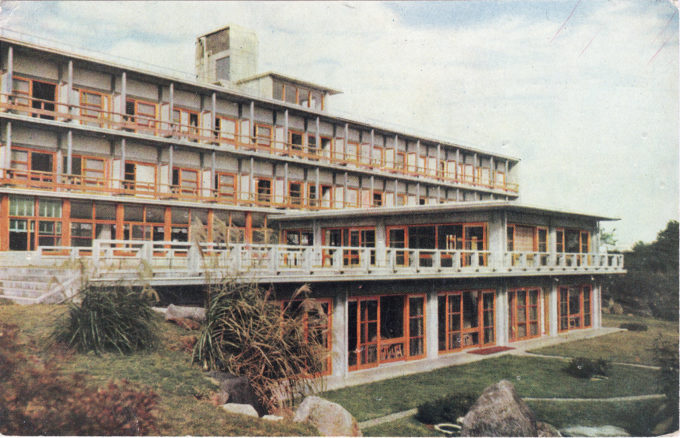
International House, Azabu, Tokyo, 1968. The ‘I-House’ origins date back to an encounter between John D. Rockefeller III and Matsumoto Shigeharu in 1929. They recognized the importance of the cultural dimension within international affairs and worked together for the rest of their lives promoting international understanding through cultural exchange and, after war’s end and the founding of I-House in 1952, to the rebuilding of postwar US-Japan cultural relations.
“Most of the eleven weeks I was in Tokyo [in 1958] – living almost luxuriously in that cultural caravanserai known as The International House of Japan, on a hill in Azabu in grounds once owned by the famous family of Iwasaki. From my balcony I had, to right and left, contrasting views, symbolizing perhaps the ancient and eternal, and the modern and ephemeral. To the right, rising over a line of blue hills, was Mount Fuji. To the left, soaring vertically from the trees of Shiba, was that astonishing structure, the Tokyo Tower.
“At night, while the distant sounds might be those of an aeroplane warming up its engines at Haneda, or a ship hooting as it moves to its berth at Shibaura, or of the siren of a police car racing towards Roppongi, the noises close at hand are those of the geta along the pavement, of the clap-clap of the night watchman on his rounds, of the noodle-seller playing that short, plaintive, unforgettable melody on his thin little flute.”
– ‘British Scholars in Japan’, by Richard Storry, Japanese Experiences: Fifty Years, One Hundred Views, compiled and edited by Hugh Cortazzi, 2001
“The International House of Japan is a private, non-profit organization incorporated, with support from the Rockefeller Foundation and other private institution and individuals, in 1952 for the purpose of promoting cultural exchange and intellectual cooperation between the peoples of Japan and those of other countries.
“Housed in a handsome structure built in 1955 and enlarged in 1976, it is a working international community engaged directly in a variety of programs that embody the free exchange and interaction of ideas and that strive to foster a climate favorable to international cooperation.
“The site of the International House of Japan formerly held a mansion belonging to the Kyōgoku Clan, feudal lords of Tadotsu Fief in present Kagawa Prefecture, during the Edo period up to the very last days of the Tokugawa Shogunate in the late 19th century.
“Early in the Meiji period ownership shifted to Inoue Kaoru, then foreign minister, and elaborate banquets were held to show his tea house, Hassō-an, in April 1887, with the Emperor and Empress Meiji, the Empress Dowager and ambassadors of various countries in attendance.
“After Inoue Kaoru, this property was possessed by Prince Kuninomiya, the Akaboshi, and the Iwasaki families. Finally, it was passed on to government ownership after World War II and was disposed of to the I-House.
“In 1955 the International House building was constructed under the collaboration of three prominent Japanese architects – Maekawa Kunio, Sakakura Junzō, and Yoshimura Junzō – and in 1976 the building was expanded using Maekawa’s design. The I-House building has been awarded the Architectural Institute of Japan Prize and in August 2006 was registered as a tangible cultural property by the Agency for Cultural Affairs of Japan.”
– International House of Japan web site



